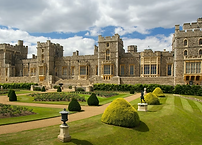
windsor castle
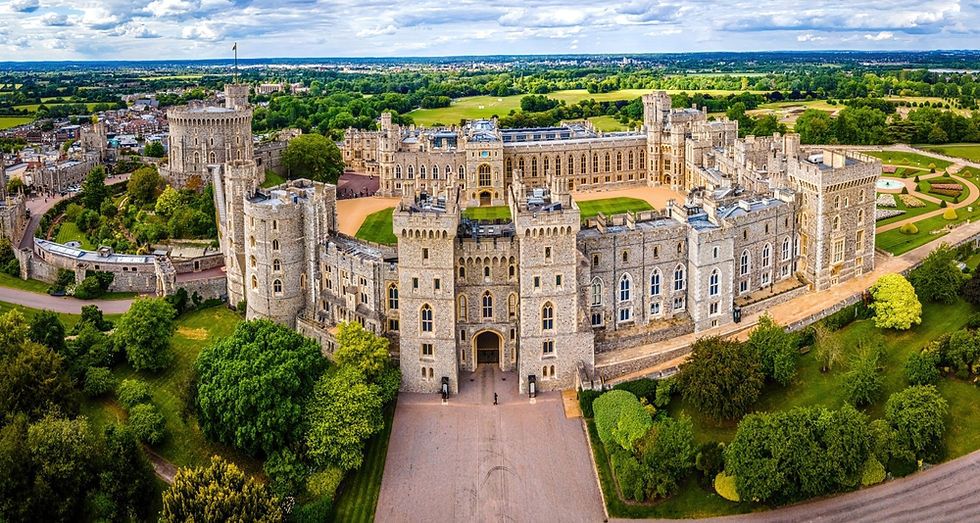
the history of the castle
Windsor Castle, a remarkable vestige of British history and culture, is an iconic royal residence that has been home to the monarchy for nearly a millennium. This venerable fortress, located in the county of Berkshire in the South East region of England, is a cornerstone of the United Kingdom's heritage and a testament to the lasting legacy of the British monarchy.
Its physical location plays a significant role in its historical and strategic significance. It is situated on a high ground, providing a vantage point over the surrounding landscape and enhancing its natural defenses. The castle overlooks the River Thames and sits about 22 miles west of London, providing easy access to the country's political capital. Its placement on the outskirts of the town of Windsor also lent its name to the castle itself.
Windsor Castle's origins trace back to the 11th century, during the reign of William the Conqueror. In 1066, William recognized the strategic importance of the site for its potential to control a critical part of the River Thames and as an outpost to protect London. He ordered the construction of a motte-and-bailey castle, a traditional Norman defensive structure featuring a wooden or stone keep situated on a raised earthwork known as a motte, accompanied by an enclosed courtyard, or bailey. Windsor Castle was one of the first in a series of such castles built around London, establishing a defensive ring around the capital.
As centuries passed, the castle evolved from its initial defensive structure to a more elaborate and palatial form. Henry II, in the late 12th century, replaced the original wooden keep with the Round Tower, and King Henry III and Edward III transformed it into a grand royal palace during the 13th and 14th centuries, establishing it as the monarch's principal residence.
Windsor Castle underwent significant changes during the Tudor period. Henry VIII, known for his fondness for opulence, made substantial alterations to the castle. His modifications reflected the changing times, as Windsor Castle gradually transitioned from a fortress to a luxurious palace. The Tudor monarchs used the castle not just as a residence but also as a stage for diplomatic meetings, hosting various European dignitaries.
In the 17th century, during the English Civil War, the castle was used as a military headquarters by Parliamentary forces and later as a prison for Charles I. It sustained some damage during this period but was later restored under Charles II, who sought to emulate the grandeur of the French court at Versailles. He refurbished the state apartments with extravagant Baroque interiors, further cementing Windsor Castle's status as a royal residence.
In the 19th century, the castle entered another phase of major renovation under the reign of Queen Victoria and Prince Albert. They commissioned architect Jeffry Wyatville to modernize the castle, resulting in a dramatic transformation that included the heightening of the Round Tower, the creation of the iconic skyline, and the addition of the magnificent Waterloo Chamber. Queen Victoria's reign marked a period where Windsor Castle became a symbol of the British Empire's stability and the monarchy's continuity.
A significant event in the 20th century was the Windsor Castle fire in 1992. The fire severely damaged a large portion of the castle, including St. George's Hall and the private chapel. This catastrophe triggered a comprehensive restoration effort that lasted five years. Today, the restored areas are virtually indistinguishable from the original sections, a testament to the meticulous restoration work.
Today, Windsor Castle is not only a monument of historical significance but also a living royal residence, used for state occasions and official royal duties. Visitors have the opportunity to explore several notable areas within its walls.
One of the most iconic features of Windsor Castle is the Round Tower, a central feature of the castle and a symbol of its enduring strength. While the public can't typically access the tower's interior, visitors can walk up the hill on which it stands, providing stunning views of the castle grounds and the surrounding countryside.
Windsor Castle's State Apartments are another must-see, filled with incredible works of art from the Royal Collection, including paintings by renowned artists such as Rembrandt, Rubens, and Canaletto. The rooms in the State Apartments range from the grand to the intimate and offer a glimpse into the lives of the royals who have resided there.
The Semi-State Rooms, restored to their 19th-century design following the 1992 fire, provide another fascinating view of royal life. However, they are only open to visitors during the winter months, as they are still in use by the Queen for official functions.
St. George's Chapel, located within the castle precincts, is a place of worship for the Queen and a site of royal weddings and burials. The chapel, a fine example of Gothic architecture, is home to the Order of the Garter, the oldest order of chivalry in the world. Here, visitors can view the tombs of ten sovereigns, including Henry VIII and Charles I.
Queen Mary's Dolls' House, another popular attraction, is a marvel of craftsmanship and design. Built in the 1920s for Queen Mary, the wife of King George V, the dollhouse is a perfect miniature replica of an aristocratic home, complete with functioning amenities and intricate details.
The Changing the Guard ceremony is another key attraction. This traditional ceremony involves a formal change of the guards posted at the castle, accompanied by a band playing traditional military marches, contemporary songs, and often, famous tunes from musicals.
Windsor Castle offers visitors a deep dive into the rich history and grandeur of British royalty. From its strategic origins under William the Conqueror to its evolution as a royal residence, and its continued use as an official venue for the monarchy, the castle stands as an enduring symbol of the UK's royal heritage. Its compelling blend of history, architecture, and art ensures its continued allure for visitors from around the world.
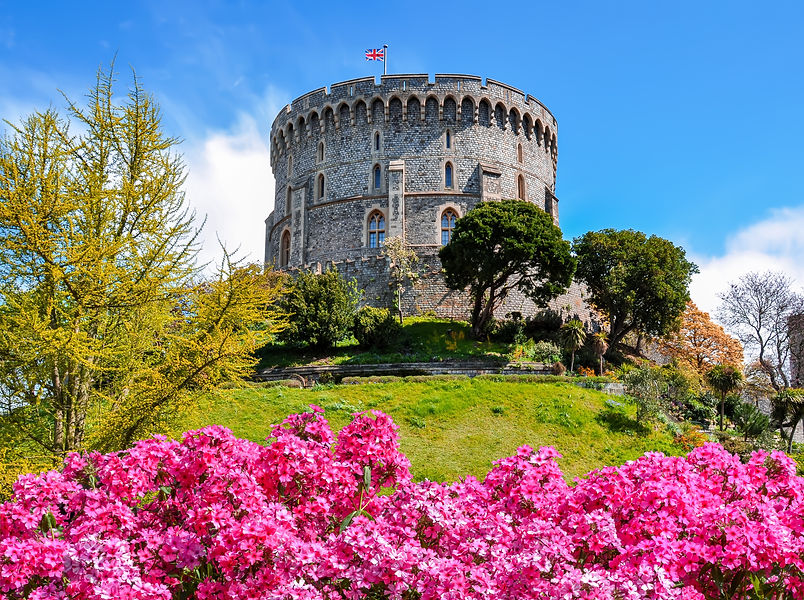
round tower
The Round Tower's monumental structure and central location within the castle complex are key visual identifiers of the royal residence. Rising majestically above the surrounding landscape, the tower occupies a dominant position in the local topography, punctuating the skyline of the historic town of Windsor.
The Round Tower's story began almost a millennium ago, in the aftermath of the Norman Conquest of England. William the Conqueror had identified Windsor as a strategically important site that could guard the western approach to London and keep a watchful eye over the River Thames. Initially, the Castle’s structure followed the traditional motte-and-bailey design, typical of Norman fortresses of the time. The Round Tower was built on the motte, a raised earthwork, with the rest of the castle - the bailey - surrounding it.
The initial structure of the tower, constructed under the orders of William the Conqueror, was likely made of wood. Henry II, the great-grandson of William, who reigned in the late 12th century, is credited with replacing the wooden structure with a stone shell keep, which substantially forms the structure seen today. This stone keep, effectively a wall of stone that enclosed a space within, was built around the motte, giving rise to the Round Tower.
Throughout the centuries, the Round Tower was put to varying uses as the castle's significance evolved from military stronghold to royal residence and administrative center. It was primarily a stronghold during the medieval period. However, as threats faded and the emphasis of the castle shifted towards administrative and residential roles, the tower's usage also altered.
It was King George IV who, in the 19th century, decided to raise the height of the Round Tower. This move was more for aesthetic purposes than defensive ones, and it dramatically altered the skyline of Windsor Castle. The remodeled tower created a more romantically medieval image for the castle, fitting in well with the gothic architectural fashion of the period.
The tower underwent further changes in the 20th century, particularly during and after World War II. During the war, when the threat of German invasion loomed large, the Round Tower was refitted for modern warfare. Post-war, the rooms that had been added within the tower were utilized as additional storage for the Royal Archives, reflecting another transition in the tower’s function.
Today, the Round Tower remains an integral part of the Castle, not just as an architectural feature but also for its functional use. It houses the Royal Archives, an immense collection of documents related to the British monarchy and government. These include personal correspondence, diaries, household records, and other valuable documents dating back to the 18th century. The Round Tower thus serves as a critical center for the study and understanding of British history.
Visitors to Windsor Castle can ascend the Round Tower during the summer months through a guided tour. This journey involves a climb of 200 steps up a steep, spiral staircase. The reward for this ascent is a breathtaking view from the top, providing a panoramic vista of the castle grounds and the surrounding countryside, as far as London's skyline on a clear day.
Notably, the Round Tower isn't just a visitor attraction; it also serves a practical purpose. The flag flying atop the tower serves as a signal of the Queen's presence: when the Queen is at Windsor, the Royal Standard flag is flown; otherwise, it is the Union Flag that adorns the tower.
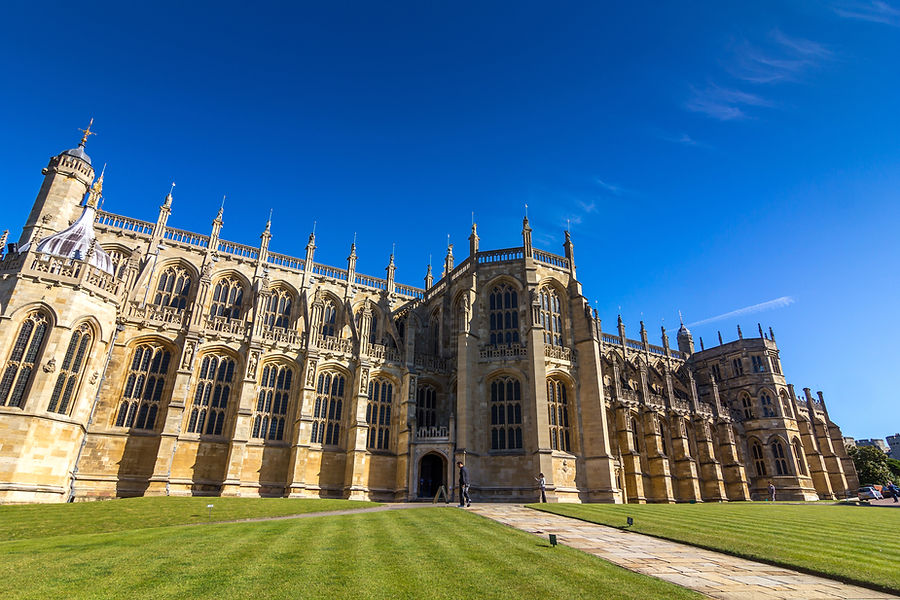
st. george's chapel
St. George’s Chapel represents an architectural masterpiece and serves as an important historical and religious landmark. It is located within the Lower Ward of the castle, separate from the State Apartments and Round Tower in the Upper Ward. A splendid example of Gothic architecture, the chapel holds significant importance due to its rich history, intricate design, and religious and royal significance.
The history of St. George's Chapel dates back to the 14th century when King Edward III founded it as a royal peculiar, a place of worship directly under the jurisdiction of the monarch. He established the chapel as the chapel of the Order of the Garter, Britain's highest order of chivalry, in 1348. Edward III, inspired by Arthurian legends, sought to create a group of knights that would be recognized throughout Europe, making the chapel an integral part of his plan. The Order still holds its annual service at the chapel, maintaining a tradition that has spanned over six centuries.
The chapel, as it stands today, was not completed until a century later. The construction was carried out in two phases over the 15th and 16th centuries. The Quire (the area of the church where the choir sits) and the aisles were built first, during the reign of Edward IV in the 1470s. The Nave, entrance porch, and the iconic large west window were added later under the supervision of Henry VII, who was also responsible for the construction of the Chapel at Westminster Abbey.
St. George's Chapel is constructed in the Perpendicular Gothic style, the final phase of Gothic architecture in England, distinguished by its strong vertical lines and elaborate fan vaulting. The chapel's exterior is characterized by flying buttresses and large, intricate stained glass windows, while the interior displays a stone fan vaulted ceiling, a key characteristic of the Perpendicular Gothic style. The fan vaulting in the Quire was the work of English master masons Hugh Herland and Robert Janyns.
The building's length from east to west is 198 feet, while the height of the Nave is 92 feet. The chapel is divided into bays, each separated by clustered columns that lead up to the fan-vaulted ceiling. The tall, slender columns and the pointed arches lend an impression of height and grandeur to the structure.
From an artistic standpoint, St. George's Chapel is a treasure trove. One of the most striking elements is the collection of stained glass windows. The windows, dating from the late 15th to the early 16th century, depict a variety of scenes from the Bible and the lives of the saints, as well as coats of arms of the Knights of the Garter.
The choir stalls, located in the Quire, are another prominent feature. They are adorned with the coats of arms and insignia of the Knights of the Garter, representing a colorful array of heraldic emblems. Above the stalls hang banners of the current knights, adding to the historic atmosphere of the chapel.
St. George's Chapel also houses several significant tombs and memorials.
The chapel serves as the final resting place for ten British monarchs, including Edward IV, Henry VIII (who is buried alongside his third wife, Jane Seymour), Charles I, George III, George IV, William IV, Edward VII, and George V.
One of the most ornate tombs is that of Edward IV, located in the Quire. It features a beautiful metal grille and canopy crafted by Belgian artist Betrand LeCavre. In contrast, Henry VIII's grave is surprisingly unmarked, reflecting the tumultuous period of the Reformation during which he died.
Another place of interest is the Lady Chapel, also known as the Tomb House. It was originally intended by Henry VII to be his burial place, but he was instead interred in Westminster Abbey. The Lady Chapel was later repurposed by George III to house a memorial to his parents, Frederick, Prince of Wales, and Princess Augusta.
The Albert Memorial Chapel, originally built as a royal mausoleum by Henry VII, was transformed into a memorial chapel by Queen Victoria for her beloved husband, Prince Albert. It features some of the most elaborate Victorian design elements in the entire chapel, with vibrant mosaics and ornamental design.
Today, St. George's Chapel continues to serve both religious and royal functions. It hosts daily services that are open to the public and has been the venue for several recent royal weddings, including that of Prince Harry and Meghan Markle in 2018.
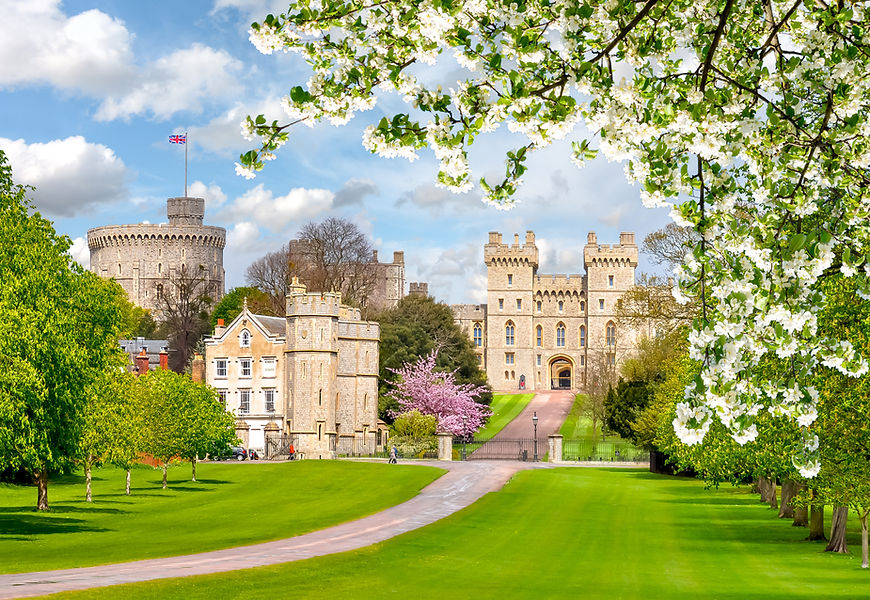
green spaces
Windsor Castle is not only famed for its majestic and architecturally significant structures but is also complemented by an array of scenic green spaces that amplify its enchanting beauty. These green areas, comprising lush lawns, manicured gardens, and extensive parks, contribute significantly to the castle's charm and historical appeal.
The most significant green area near Windsor Castle is the Great Park, now known as Windsor Great Park. It is a vast royal park spreading over 4,800 acres, which originally served as a private hunting ground for Windsor Castle. The park, rich in history and wildlife, has been associated with the castle since the time of William the Conqueror, who reigned in the 11th century. The park was used extensively for deer hunting, a favored pastime of many British monarchs. It is home to around 500 red deer, direct descendants of the deer hunted by the castle's medieval monarchs.
The Windsor Great Park comprises several areas of interest. The Long Walk, stretching from the castle’s George IV Gateway to the Copper Horse statue of King George III, is one of the most famous features. It spans 2.65 miles and is flanked by double avenues of elm trees, a stunning sight at any time of the year. The avenue ends at Snow Hill, where the Copper Horse statue offers breathtaking views of the castle.
The Valley Gardens, situated in Windsor Great Park, is another notable green area. It covers 250 acres of the park and is a spectacle of natural beauty with its colorful flowering plants, shrubs, and ornamental trees. The garden is known for its remarkable collection of rhododendrons, azaleas, camellias, magnolias, and other flowering shrubs.
Another green area of importance is the Savill Garden, an enclosed part of Windsor Great Park. It was created by Sir Eric Savill in the 1930s and is a prime example of a British ornamental garden. The garden is divided into several sections, each with its distinctive character and style, ranging from formal gardens to more exotic woodland areas.
Home Park, adjoining the castle to the east, is another significant green area. It houses Frogmore House and its gardens, the private residence of several monarchs and their families over the centuries. The grounds of Frogmore are notable for their lush, tranquil ambiance, and they also include the Royal Burial Ground.
The green areas around Windsor Castle are not only aesthetically pleasing but are also rich in wildlife. They host various bird species, including swans, ducks, and herons, and serve as habitats for a wide range of flora and fauna. This diversity adds another layer of charm and interest to these green areas.
From an environmental perspective, these green areas play a vital role in maintaining local biodiversity and providing ecological stability. They are vital spaces for local wildlife, and their upkeep contributes to the sustainability efforts of the region.
Moreover, the green areas also contribute to the historical narrative of the castle. For instance, the gardens at Frogmore House have witnessed several key events in royal history. Queen Victoria often took a keen interest in the gardens and green areas, which reflects in their meticulous design and maintenance.
For visitors, these green areas offer a plethora of recreational activities. Long, serene walks along the Long Walk or amidst the Valley Gardens, wildlife spotting in Windsor Great Park, or picnicking near the serene waters of Virginia Water Lake – the options are as varied as they are delightful.
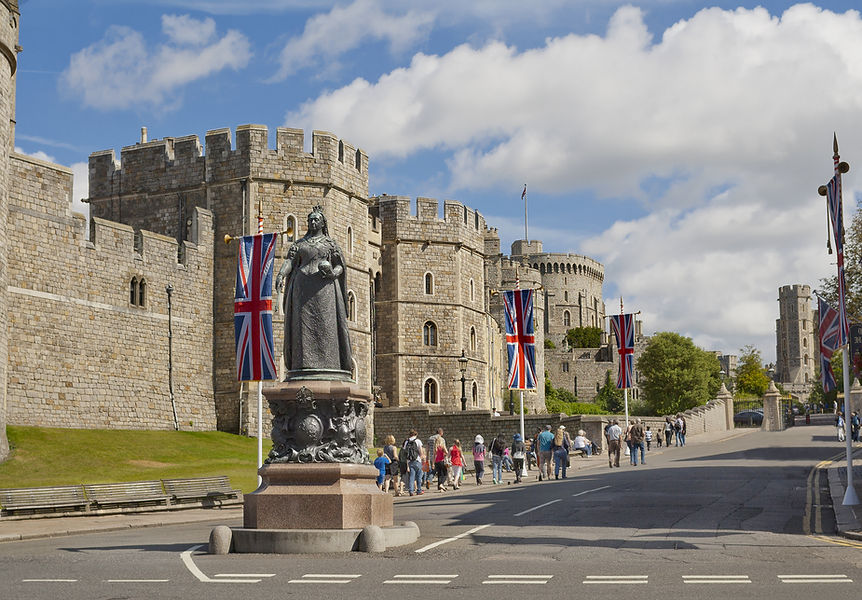
tickets and opening times
Getting to Windsor Castle from London
Conveniently located just west of London, Windsor Castle is easily accessible by road and rail. The quickest and most convenient way to reach the castle is by train. There are direct train services from both London Waterloo and London Paddington that will take you to Windsor & Eton Riverside or Windsor & Eton Central stations, respectively. The journey time is approximately an hour. From either station, it's a leisurely 5-10 minute walk to the castle.
If you prefer to drive, Windsor is around 20 miles from central London and can be reached via the M4 motorway. Keep in mind that the town can get quite busy, particularly on weekends or public holidays, so be sure to plan your journey accordingly.
Windsor Castle Opening Times
Windsor Castle opens its doors to visitors throughout the year, with its operating hours varying slightly according to the season. From March to October, the castle is open from 10:00 AM to 5:15 PM. From November to February, the timings change to 10:00 AM to 4:15 PM. The last admission is precisely 1 hour and 15 minutes before the castle closes. However, it is recommended to allow at least 2-3 hours for your visit to fully experience everything the castle has to offer.
Please note that the castle is a working palace, and therefore closures can occur at short notice for state functions. It's always a good idea to check the official website for the most up-to-date information before your visit.
Where to Buy Tickets for Windsor Castle
Tickets for Windsor Castle can be purchased in several ways. The most straightforward method is to buy tickets online from the official Royal Collection Trust website. Buying online not only secures your entry but also allows you to bypass potential queues at the ticket office.
You can also buy tickets in person at the Windsor Castle admissions center, which is located right outside the castle. However, during peak tourist season, there might be a wait.
Ticket prices vary according to age and group size, with concessions available for seniors and students. There are also family tickets available. One great feature of Windsor Castle tickets is the 1-Year Pass, which allows you to convert your ticket into a pass that grants you free re-admission for a year.

